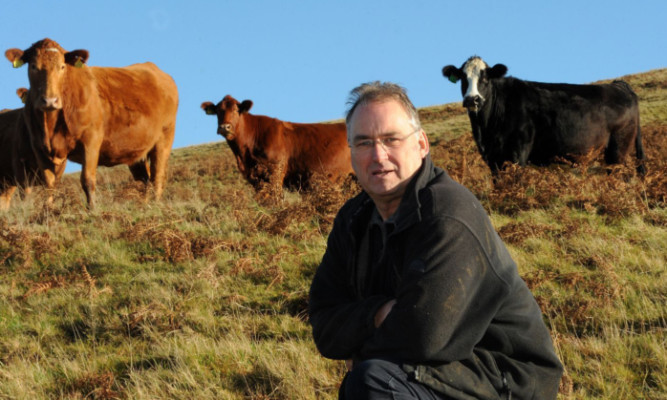Making the best use of upland resources is the theme of a free Planning for Profit meeting to be held at David Kirkpatrick’s Auchenbainzie Farm at Thornhill, Dumfries, next Wednesday.
Much of the discussion is likely to revolve around the recent CAP reform and how hill farms in Scotland will be affected.
Mr Kirkpatrick has already made steps over the last 10 years to reduce costs and to improve efficiency and profitability in the dairy, cattle and sheep enterprises on his 2,000-acre unit in the Nith Valley.
About 10 years ago he carried out a whole-farm review, with the result that he increased the milking cows by 70 to 190 and reduced the suckler herd from 300 to 115.
He said: “We decided to utilise the best low ground land for milking cows and use the 1,000 acres of hill for youngstock and dry cows, which meant reducing beef cow numbers.”
Around the same time, following a visit to the USA, Mr Kirkpatrick introduced Stabiliser cows. These are out-wintered, therefore stocking rates are not so high, but returns per cow have improved dramatically to average £641 per cow in 2013/14.
He said: “I was impressed with the Stabilisers I saw in Montana. They combine the thriftiness of our hardy native breeds with the productivity of continentals.”
In his pursuit of better margins, Mr Kirkpatrick tried many ways to reduce costs, but said that by far the most effective was out-wintering cattle.
The cows go out to the hill after weaning in October.
They receive no extra forage or concentrate until March, when they are fed with a snacker, through calving in April before coming on to better grazing in May to be synchronised and bulled through the summer.
This system has seen an average 93% of calves reared in the last three years.
Another advantage of the Stabiliser is that the heifer calves are in demand for breeding, and those not kept for replacements are sold as bulling heifers at 12 to 14 months for a premium price. Last year they averaged £1,300.
Most of the bull calves are sold at weaning in October, when they average 273kg liveweight, to a finishing unit in Yorkshire for the Morrisons Beef Scheme.
However 15 to 20 of those with potential for breeding are kept and either sold as stock bulls at 14 months old for an average of £5,000 or finished and sold deadweight.
The low-cost, easy-care system Mr Kirkpatrick employs for his cattle is equally effective in his sheep flock.
During the farm review he changed from traditional Scotch Mule production to running 2,000 Lleyn ewes on the farm. This includes ewe lambs which are put to a Shetland tup for easy lambing, while some of the ewes are tupped by Lleyn rams for replacements.
They all lamb outdoors in April. Progeny is sold on a deadweight basis through Lawrie & Symington to Vivers and Dunbia. Average weights and grades are 19kg at R3L.
By changing the sheep system, Mr Kirkpatrick said: “Costs and labour have been enormously reduced but the end value not so much.”
For a number of years now, he has been using New Zealand Suffolk cross Texel rams on the majority of the flock, which he sources in Shropshire, and said they are much more vigorous than home-bred lambs, easily tupping 100 ewes each per season.
The whole set-up of dairy, beef and sheep farming is run with the help of just three men thanks to the efficient integration of the three units with the best use of the lowland and upland grass available.
To attend the Planning for Profit meeting and find out more about the beef and sheep enterprises at Auchenbainzie on Wednesday at 10.30am please call Kirsty at QMS on 0131 4724040 or email info@qmscotland.co.uk.
